Smartphone Audio Quality Testing
by Chris Heinonen on December 8, 2013 5:15 PM EST- Posted in
- Smartphones
- Audio
- Mobile
- Tablets
- Testing
THD+N is a measure of the total harmonic distortion and noise compared to the signal. The lower the number, the less distortion and noise there is relative to the fundamental frequency. THD+N is measured by driving a 1 kHz sine wave at maximum volume. Because there is always some inherent background noise, the THD+N is almost always lowest at maximum output so that is used for the measurement.
There are two results that we take from this: a sine wave and a FFT spectrum. On the sine wave both channels should line up perfectly, and it should be as close to an accurate sine wave as possible. On the FFT we want to see a peak at 1 kHz and everything else as low as possible. The most common artifact you will see are harmonic sidebands at multiples of 1 kHz.
For an example of data that looks good, here is the sine wave of the iPhone 5. We see a sine wave that is good, with channels that overlap perfectly and no deviation. This is what we expect to see.
Now for a different example we look at the Nexus 5. Run at maximum volume we see that the left channel is clipping in the sine wave. Likely the power to the headphone amplifier is not enough to drive both channels and so this is the result. UPDATE: Tested this with 4.4.1 and no change.
The iPhone 5 produces a THD+N ratio of 0.003134% while because of the clipping, the Nexus 5 is producing 13.789197%. Any level over 1% is considered to be past the clipping point of an amplifier and it seems that the Nexus 5 cannot be driven at maximum volume. I tested two samples to verify, and on both the performance is identical.
Now if we look at the FFT for this test, we see how this distortion is showing up. First, the iPhone 5 is very quiet.
There is a 2 kHz peak that is -93 dB below the fundamental frequency, and the 3rd harmonic at 3 kHz is over -109 dB below it. All the harmonics past that are at -120 dB below the fundamental tone. There is some noise out at 50 kHz but this is so far past the level of human hearing that it is safely ignored. Now the Nexus 5 FFT.
We see the right channel, which didn’t clip, looks good. The 2nd harmonic is -111 dB and the 3rd harmonic is -93 dB. On the left channel the 2nd harmonic is only -18 dB and the 3rd harmonic is -24 dB. Even at the 9th harmonic we are still only -52 dB below the fundamental tone. This is causing these incredibly high THD+N numbers that we are seeing on the Nexus 5. We will see more detail of this on a later test as well.
We also chart THD+N vs. Frequency. Here is the chart for the Note 3.
We see that THD+N is basically right below 0.08% for the whole spectrum. It moves up and down slightly, but is very constant. Now here is that Nexus 5 data.
We see that the right channel is around 0.01% THD+N while the left channel, the clipped one, is over 3%. If we ran the Nexus 5 at a lower volume level we would see totally different results, as you’ll find out later, but this is how devices are typically measured.


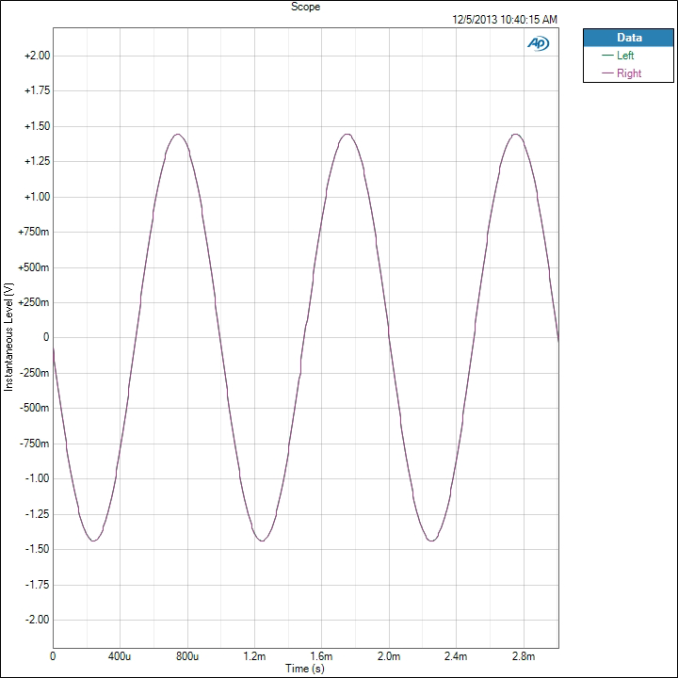
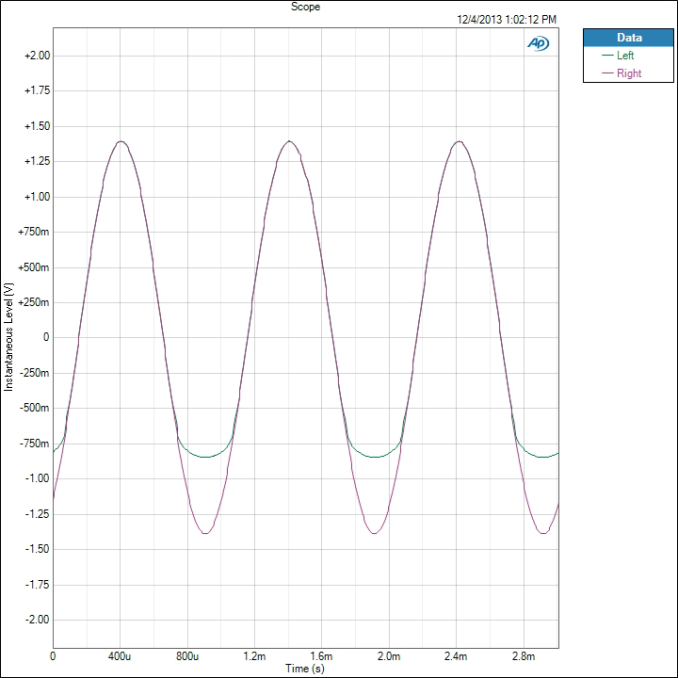
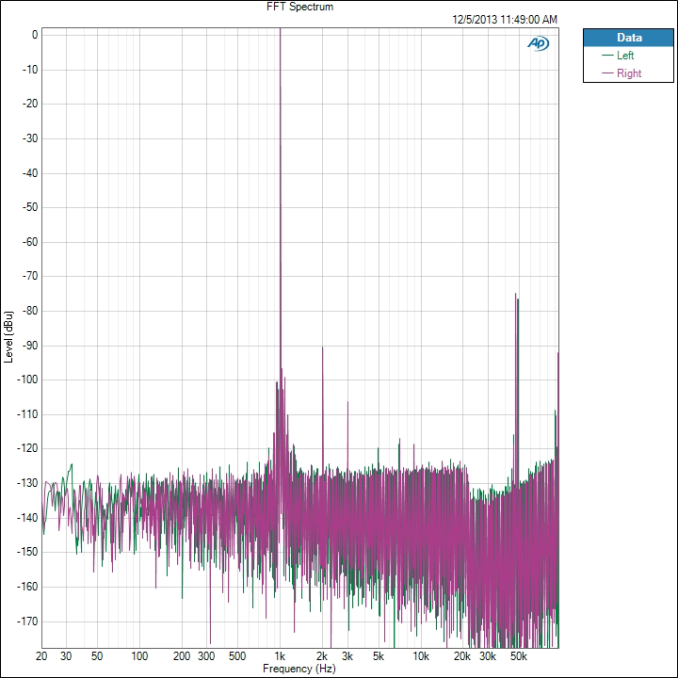
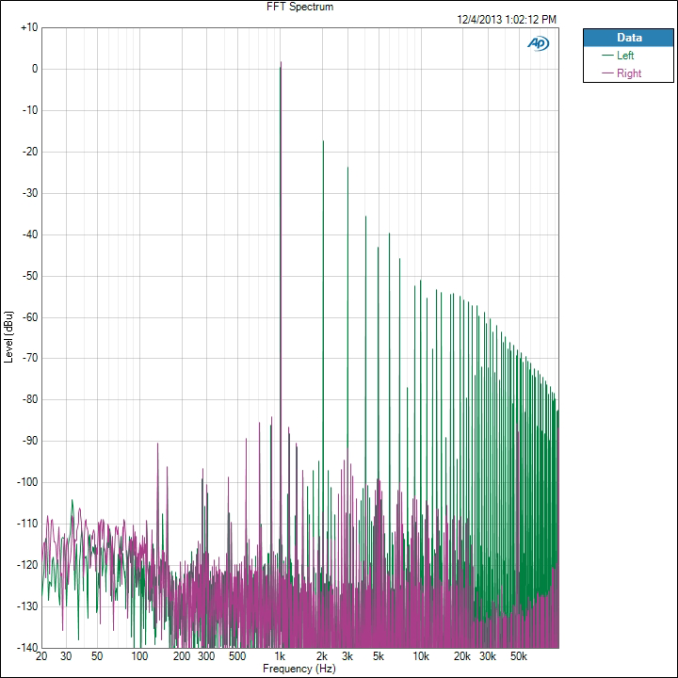
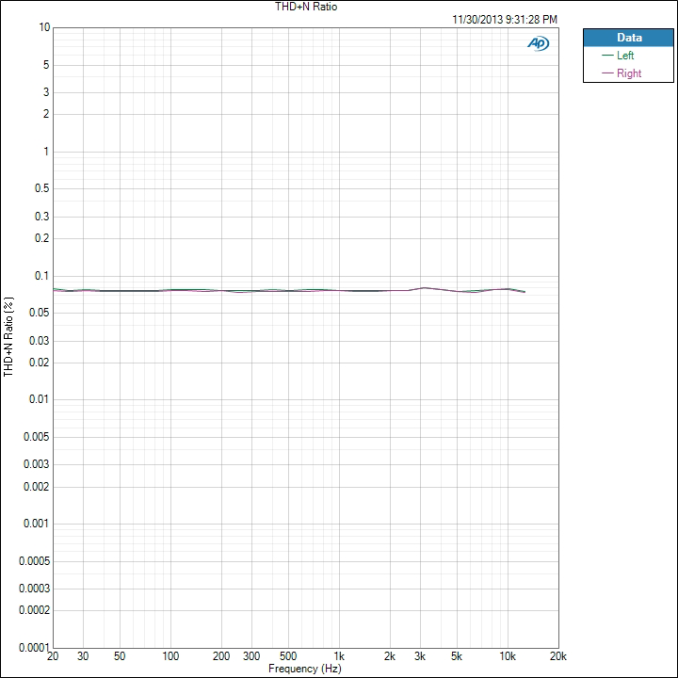









188 Comments
View All Comments
lmcd - Sunday, December 8, 2013 - link
Only Anandtech :-)Curious to see how (badly) the S3 fares.
Old_Fogie_Late_Bloomer - Sunday, December 8, 2013 - link
Even with the occasional stinker of an article (yay, non-removable batteries...?), I have to say......it's stuff like this that keeps me coming back to the site. Only Anandtech, indeed. :) Keep up the quirky, in-depth work.
althaz - Sunday, December 8, 2013 - link
I don't know about the S3, but the S2 was rated very highly for audio quality.quick brown fox - Sunday, December 8, 2013 - link
I believe it was the opposite; S3 was lauded due to its wolfson dac (as well as the original Galaxy S), while S2 was condemned for not using that same DAC.Hopefully all gets measured so we can have some objectivity involved.
MadMan007 - Sunday, December 8, 2013 - link
Yeah but talking about a specific DAC chip is audio nerds looking at just a piece of the equation and using it as a potential red herring. The analog amplifiers and output, and overall implementation, matter much more than which specific DAC chip is used as long as it's not garbage, meaning basically any modern DAC chip.krazyfrog - Monday, December 9, 2013 - link
AnandTech actually tested the audio of the international Galaxy S II in their review and found it to be quite poor.zShowtimez - Monday, December 9, 2013 - link
After just moving from a S2 to a HTC One, let me tell you how awful the S2 was...Samus - Monday, December 9, 2013 - link
The surface(s) all use a wolfson dac and sound fantastic, too. The implementation means nothing if your base source is some realtek crap.Hemlocke - Sunday, December 8, 2013 - link
The i9100 had the Wolfson DAC, but the U.S. Variants didn't.onslaught86 - Sunday, December 8, 2013 - link
The i9100 did not have a Wolfson DAC. The i9300 did, while its US variants did not. And boy was it night & day coming from the i9100.